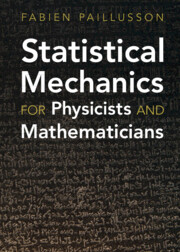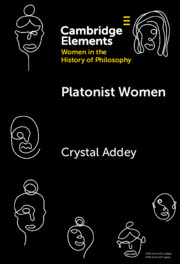Refine search
Actions for selected content:
3372602 results
Women and mental health in Italy: feminism, psychiatry and asylums in 1970s Turin
-
- Journal:
- Modern Italy , First View
- Published online by Cambridge University Press:
- 29 July 2025, pp. 1-23
-
- Article
-
- You have access
- Open access
- HTML
- Export citation
Thin-layer formation of ellipsoidal gyrotactic swimmers in time-dependent hydrodynamic shear
-
- Journal:
- Journal of Fluid Mechanics / Volume 1016 / 10 August 2025
- Published online by Cambridge University Press:
- 29 July 2025, A8
-
- Article
-
- You have access
- Open access
- HTML
- Export citation
Kristie Patricia Flannery, Piracy and the Making of the Spanish Pacific World University of Pennsylvania Press, 2024, pp. 296
-
- Journal:
- Journal of Latin American Studies , First View
- Published online by Cambridge University Press:
- 29 July 2025, pp. 1-3
-
- Article
- Export citation
THE COMEDIES OF DIPHILUS - (A.) Maggio Ricerche su Difilo di Sinope. (Polymnia 29.) Pp. xii + 476. Trieste: Edizioni Università di Trieste, 2023. Paper, €35. ISBN: 978-88-5511-382-3. Open access.
-
- Journal:
- The Classical Review , First View
- Published online by Cambridge University Press:
- 29 July 2025, pp. 1-3
-
- Article
- Export citation
Assessment of medical device features in health technology assessment: a review of NICE medical technology guidance
-
- Journal:
- International Journal of Technology Assessment in Health Care / Volume 41 / Issue 1 / 2025
- Published online by Cambridge University Press:
- 29 July 2025, e60
-
- Article
-
- You have access
- Open access
- HTML
- Export citation
Empowering Affected Interests: Democratic Inclusion in a Globalized WorldArchon Fungand Sean W.D. Gray , eds. Cambridge University Press, 2024, pp. 296
-
- Journal:
- Canadian Journal of Political Science/Revue canadienne de science politique , First View
- Published online by Cambridge University Press:
- 29 July 2025, pp. 1-2
-
- Article
- Export citation
Balancing Pressures: The Politics of Governing the European Economy By Fabio Franchino and Camilla Mariotto, Cambridge, UK: Cambridge University Press, 2025. 274p. $120.00 hardback, $41.99 paperback, $41.99 e-book.
-
- Journal:
- Italian Political Science Review / Rivista Italiana di Scienza Politica , First View
- Published online by Cambridge University Press:
- 29 July 2025, pp. 1-3
-
- Article
- Export citation
Modelling transitional rough-wall turbulence with quasi-linear approximations
-
- Journal:
- Journal of Fluid Mechanics / Volume 1016 / 10 August 2025
- Published online by Cambridge University Press:
- 29 July 2025, A7
-
- Article
- Export citation
Diagnosis of postpartum depression and associated factors in South Africa: a cohort study of 47,697 women
-
- Journal:
- Epidemiology and Psychiatric Sciences / Volume 34 / 2025
- Published online by Cambridge University Press:
- 29 July 2025, e41
-
- Article
-
- You have access
- Open access
- HTML
- Export citation

Teaching the Arts
- Early Childhood and Primary Education
-
- Published online:
- 28 July 2025
- Print publication:
- 06 August 2025
-
- Textbook
- Export citation

Liquid Languages
- Constructing Languages in Late Modern Cultures of Diffusion
-
- Published online:
- 28 July 2025
- Print publication:
- 14 August 2025

Galen on Human Physiology
- Taking the Body Apart and Putting it Back Together Again
-
- Published online:
- 28 July 2025
- Print publication:
- 30 September 2025

Statistical Mechanics for Physicists and Mathematicians
-
- Published online:
- 28 July 2025
- Print publication:
- 14 August 2025

Kant on Social Suffering
-
- Published online:
- 28 July 2025
- Print publication:
- 21 August 2025
-
- Element
- Export citation

Platonist Women
-
- Published online:
- 28 July 2025
- Print publication:
- 21 August 2025
-
- Element
- Export citation

Writing the Detectives
- Character and the Series Form
-
- Published online:
- 28 July 2025
- Print publication:
- 21 August 2025
-
- Element
- Export citation
Density and unitarity of the Burau representation from a non-semisimple TQFT
- Part of
-
- Journal:
- Canadian Journal of Mathematics , First View
- Published online by Cambridge University Press:
- 28 July 2025, pp. 1-29
-
- Article
- Export citation
Equivariant vector bundles on toric schemes over semirings
- Part of
-
- Journal:
- Proceedings of the Royal Society of Edinburgh. Section A: Mathematics , First View
- Published online by Cambridge University Press:
- 28 July 2025, pp. 1-67
-
- Article
-
- You have access
- Open access
- HTML
- Export citation
Fluid dynamics in the vitreous chamber during infusion in ophthalmic surgery: a numerical study
-
- Journal:
- Flow: Applications of Fluid Mechanics / Volume 5 / 2025
- Published online by Cambridge University Press:
- 28 July 2025, E30
-
- Article
-
- You have access
- Open access
- HTML
- Export citation
Unlocking the potential of artificial nighttime lighting in agricultural fields: a novel approach to enhancing crop productivity
-
- Journal:
- The Journal of Agricultural Science , First View
- Published online by Cambridge University Press:
- 28 July 2025, pp. 1-12
-
- Article
-
- You have access
- HTML
- Export citation


